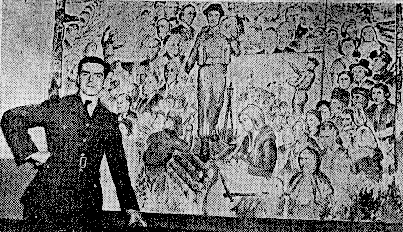An Artist at War

When Gordon Couling went to Vancouver to serve with the Royal Canadian
Engineers, he likely thought he would not be doing his beloved artwork for
quite some time. His friend J.G. Hanley, from
the Church of Saint Peter in Chains in Toronto and later The Canadian
Register in Kingston, wrote him a letter which concurrs with this fear:
It was really not surprising to hear that you were in His
Majesty's Service, though I had not heard it before. It is true that
your work will be vastly different; you will not have many churches to
decorate, or many other buildings either for that matter. But this war
will not last indefinately; there will still be much work to be done of
the kind you like to do."
-J.G. Hanley, December 29, 1942.

However, Gordon Couling found himself in the position of staff artist,
doing topographic and architectural drafting, which he had a flair for.
The Department of National Defence was very impressed with his work and
wrote an official letter to say so:
I would like to draw your attention to the excellent work done
by Sargeant G. R. Couling, R.C.E. in preparation of drawings of Vancouver
and Prince Rupert Harbour Fronts. These drawings were included in
Intelligence Coast Reports covering these two cities. The work of
Sargeant Couling is greatly appreciated by this department and I would be
grateful if this letter were brought to his attention.
-Department of National Defence, Staff Officer R. Roberts (Intelligence),
Pacific Coast Naval Headquarters, Jericho Beach, Vancouver, B.C.
During training, Gordon Couling sustained a back injury, a compression
fracture of the first lumbar vertebra and was thus unable to serve
overseas.
He went to the Canadian Legion War Services Hut, No. 1 Conditioning
Centre, Gordon Head, B.C. to recover. During his time at Gordon Head, he
managed to fill his time with artistic work and become quite the local
celebrity, being known as the "Soldier Artist". He and two other soldiers
painted murals (Gordon Couling's mural can be seen alongside him in the
picture above), as well as put on displays of artwork at their hut.
One writer for the local paper was particularly enchanted:
He was standing before an improvised easel, putting the
finishing touches to an amazingly good picture of a scene in the hut
itself. Chatting with him, I found he wore a cast for spinal injury..
...The excellence of his work made me ask if he'd done any before. And I
was interested to learn that he had been an interior decorator before the
war, doing many church interiors...
...He was amazingly cheery and evidently welcomed the opportunity given
him at the centre to follow his artistic inclinations
-Nancy Hodges, from "One Woman's Day", Victoria Daily Times, December
7th, 1944
The soldier-artists contributed their art to an exhibition held at the
Victoria Provincial Museum, to wide acclaim. It seems the public was
delighted with the prospect of Canada's young servicemen participating in
local culture. Critics enjoyed the display, and in particular two groups
of work; one by a friend of Gordon Couling and one by Gordon Couling
himself!
Two groups were outstanding.. [one of these was] a group of oils
and pen and ink sketches by Staff-Sgt. Gordon R. Couling of Guelph,
which have depth of colour and richness. Staff-Sgt. Couling, his body
still in a cast, is keenly interested in his work and has sketched many
familiar scenes in Victoria, including Christ Church cathedral. His
knowledge of architecture and especially of churches is apparant in the
sketches.
-From Victoria Daily Colonist, December 7, 1944
Although a soldier would not be expected to continue his artistic career
while stationed at a camp, Gordon Couling managed to make the most of his
situation and still hold onto his artistic dreams during wartime. It is
testimony to this man's dedication to the arts that, as a soldier and
during a time when art was still not fully a "man's hobby" that he
managed to uphold his artistic career during World War Two.

Letters and articles quoted herein were found in the Gordon Couling
Collection, Archive Centre, University of Guelph library, Guelph, Ontario.

Back to previous page
Back to Gordon Couling Home Page




